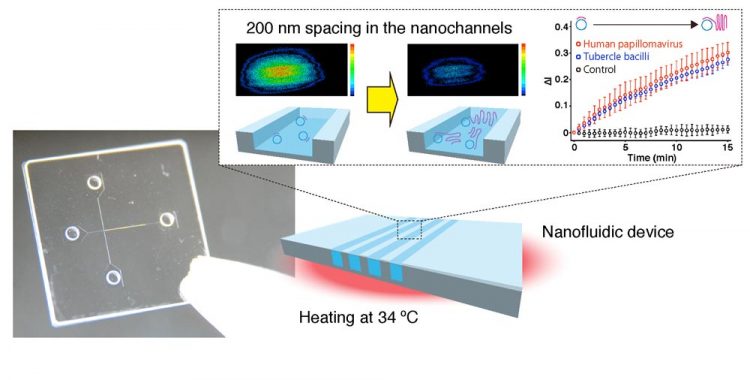Novel Nanoscale Detection of Real-Time DNA Amplification Holds Promise for Diagnostics

A photo and a schematic illustration for a nanofluidic diffraction grating. Label-free signals based on a diffraction intensity change were attributed to amplification of DNA molecules, such as human papillomavirus and tubercle bacilli. Copyright : Takao Yasui
Polymerase chain reaction (PCR) is a simple and ubiquitous method in molecular biology for amplifying DNA segments into millions of copies. This is important not only for basic research, but also in diagnostics, forensics, and medical applications.
Quantitative real-time PCR is a modified version that incorporates fluorescence labeling to cumulatively measure DNA amplification, rather than monitoring it at the end of the process, as in conventional PCR. Real-time PCR therefore enables sensitive quantification of the amount of the initial DNA template. However, current techniques may introduce bias through sequence errors, pipetting inaccuracies, or unequal binding of fluorescent probes (hybridization).
A research team centered on Nagoya University has now developed a novel method of measuring real-time DNA amplification that is label-free, thus avoiding the bias issues associated with other procedures. The research and its outcomes were reported in Scientific Reports.
Existing label-free detection systems rely on surface immobilization of target molecules, which is expensive, laborious, and ineffective over time. This new method also introduces an element of hybridization bias because of complementary probe binding.
The new technique instead detects changes in the intensity of diffracted light from a laser beam passing through miniscule 200 nm (0.0002 mm)-wide nanochannels filled with analytical sample liquids. The 532-nm laser beam is focused by a lens and then diffracted by passing through the nanochannel and detected by a photodiode. Silica substrates were used to make the nanochannels, and the larger the difference between refractive indices of sample liquids and silica, the smaller is the change in diffracted light intensity, and vice versa.
“We used this technique to provide the first label-free detection of human papillomavirus and the bacteria responsible for tuberculosis,” first author Takao Yasui says. “The method is highly sensitive, and allows quantification of a wide range of initial DNA concentrations, from 1 fM to 1 pM (a 1,000-fold range), so is superior to existing fluorescence-based detection systems.”
“Our system also measures DNA amplification at the relatively low temperature of 34°C and without the need for thermal cycles,” coauthor Noritada Kaji says. “Because it has the potential to be constructed as a single chip and can detect sample volumes as small as 1 µl, which is 100–1,000 times less than conventional detectors are capable of, it is particularly suited to development as a miniaturized form of diagnostics and microbe detection.”
The article, “Label-free detection of real-time DNA amplification using a nanofluidic diffraction grating” was published in Scientific Reports at DOI:10.1038/srep31642
Journal information
Scientific Reports
Funding information
This research was supported by the Cabinet Office, Government of Japan and the Japan Society for the Promotion of Science (JSPS) through the Funding Program for World-Leading Innovative R&D on Science and Technology (FIRST Program), Nanotechnology Platform Program (Molecule and Material Synthesis) of the Ministry of Education, Culture, Sports, Science and Technology (MEXT), Japan, the JSPS Grant-in-Aid for JSPS Fellows, the JSPS Institutional Program for Young Researcher Overseas Visits, the JSPS Grant-in-Aid for Young Scientists (B) 25790028, a Grant-in-Aid (No. 15H01599) for Scientific Research on Innovative Areas “Innovative Materials Engineering Based on Biological Diversity” from MEXT, the Asahi Glass Foundation, and PRESTO, Japan Science and Technology Agency (JST).
Media Contact
All latest news from the category: Life Sciences and Chemistry
Articles and reports from the Life Sciences and chemistry area deal with applied and basic research into modern biology, chemistry and human medicine.
Valuable information can be found on a range of life sciences fields including bacteriology, biochemistry, bionics, bioinformatics, biophysics, biotechnology, genetics, geobotany, human biology, marine biology, microbiology, molecular biology, cellular biology, zoology, bioinorganic chemistry, microchemistry and environmental chemistry.
Newest articles

A ‘language’ for ML models to predict nanopore properties
A large number of 2D materials like graphene can have nanopores – small holes formed by missing atoms through which foreign substances can pass. The properties of these nanopores dictate many…

Clinically validated, wearable ultrasound patch
… for continuous blood pressure monitoring. A team of researchers at the University of California San Diego has developed a new and improved wearable ultrasound patch for continuous and noninvasive…

A new puzzle piece for string theory research
Dr. Ksenia Fedosova from the Cluster of Excellence Mathematics Münster, along with an international research team, has proven a conjecture in string theory that physicists had proposed regarding certain equations….



